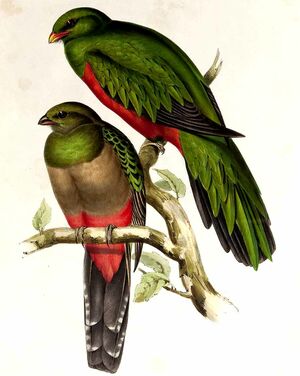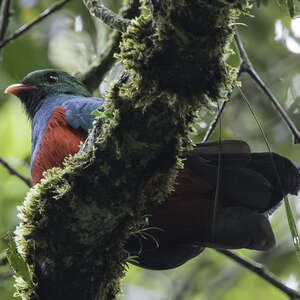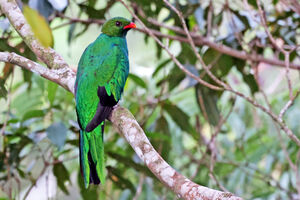Pavonine Quetzal
Pharomachrus pavoninus - Quetzal pavonin
Identification
Bird-watching has many facets, from scientific to observational, from painting to photography, videography and even etymological! Our Pavonine Quetzal, whose name derives from the Nahuatl (Aztec) word quetzal meaning 'long green feather', is closely related to the Resplendent Quetzal, but its scientific name has nothing to do with it! Pavoninus in Latin means 'with a tail of a peacock', so Johann Baptist von Spix, the German explorer and zoologist (1781-1826) dubbed the magnificent quetzal in 1824. This quetzal is difficult to observe, and its black and bluish-green coloring may have been reminiscent of the blue peacock, or Pavo cristatus, to the biologists of the 19th century! Very close to the golden quetzal - they may even form a 'super-species' - the male of our Pavonine Quetzal has slightly arc-shaped beak which is characteristic of trogonids, its mandibles being red-orange at the base and yellow at the tip. Its eye with its thin white orbital ring has a dark brown iris while its crown is golden-green, slightly less intense than that of the golden quetzal. Its throat and chest are emerald green and the border between its red belly and its chest forms a crescent-shape. Its mantle and back are green, with black markings around the base of the feathers, while the lower back and the rump show a blue-turquoise reflection. The primary and secondary green coverts are long and vertical, partially covering the black remiges which is common to many trogonids, such as white-tipped cover feathers. Its lower rectrices are black, its upper rectrices are green and when the bird fans its tail, a bluish-green center and black external parts will be visible.The female has a pale red beak and the ends of both mandibles are tinted with a dark brown mark. The head is mostly brown, with very faint greenish-gold reflections, the parotids are brown-gray, the brown throat gradually turns green on the upper part of the chest, then goes back to brown; the belly is pinkish red, the color is slightly faded compared to the color of its mate. The vertical green coverts on the black remiges are shorter than those of the male and the white edgings remain visible, the primary remiges are long and seen from the back, they cover part of the uppertail. The lower rectrices are anthracite grayish white at the end and streaked with the same white on the outer edges. Juveniles look like their mother, the coverts are speckled with chamois spots, the remiges are rather light brown, the beak is black and does not yet have the coloration of the adults.
Subspecific information monotypic species
Foreign names
- Quetzal pavonin,
- Quetzal pavonino,
- quetzal-pavão,
- Pfauentrogon,
- pávakvézál,
- Pauwquetzal,
- Quetzal pavonino,
- påfågelquetzal,
- Amazonketsal,
- kvesal páví,
- kvesal paví,
- Rødnæbbet Quetzal,
- alankoketsaali,
- quetzal pavoní,
- kwezal pawi,
- Златоглавый квезаль,
- アカハシカザリキヌバネドリ,
- 彩绿咬鹃,
- påfågelquetzal,
- 帕逢尼金頭綠咬鵑,
Voice song and call
The male Pavonine Quetzal repeats a long, five to six times echoed ew-ewwo-ewwo-ewwo... at twilight, for over an hour. Juveniles in the nest call for their parents producing a light ow-ow-ow. The male calls out to its mate with an eeeooow-eeeooow, followed by a sharp, short tuk and the female answers with a lower, soft wa...op-op-op-op.
Habitat
Behaviour character trait
Sedentary, but this species is not well known. Individuals have sometimes been spotted at higher levels than usual, perhaps in search of food.
Dietfeeding habits
As is typical of trogonids, the Pavonine Quetzal enjoys fruits, especially those from the Lauraceae family (the avocado is one such example), and various berries; but in terms of surprises, our Pavonine Quetzal doesn't seem to stop giving. Its diet consists mainly of meat, and it loves frogs! In particular, arboreal frogs of the hyla and phyllomedusa type can make up half of its dietary intake. Dan Lebbin, who made the observations, is uncertain whether the bird has specialized in gathering the amphibians or is simply taking them depending on where it is located. During his survey trips, he saw that the chick's diet mainly included various fruits and frogs in equal parts, sometimes with some insects, caterpillars, and different larvae.
Reproduction nesting
Pavonine Quetzals, being tied to the higher parts of tropical forest canopies, are difficult to observe and there is little information on nest building and reproduction. In the Amazon, breeding season usually takes place in February, while juveniles were observed in northeat Peru in mid-July. American ornithologist Edwin Willis, and his wife Yoshisda Oniki published observations made near Manaus, Brazil in 1982, where they saw a Pavonine Quetzal couple attacking a couple of Streaked Xenops, Dendrocolaptes picumnus, and chasing them away in order to reclaim the nest, which was situated around 9 meters of the ground. Dan Lebbin, an American ornithologist, observed a nest in 2007 in northeastern Peru. The nest was located in a hollow of a dead tree at a height of 4.50 meters. The couple had made a tunnel of around 10 cm in diameter, which descended about 6 cm from the entrance leading to a chamber of 21 cm height. observing started on February 18th and hatching was estimated to take place on the 22nd. Two eggs were incubated for 14 to 17 days, with the hatching date being uncertain. It was observed that the male incubated during the day and the female during the night, with the male largely responsible for feeding, and the female only coming intermittently. At 12 days, only one chick started to peek out of the nest, leaving 21 days later accompanied by his father.
Geographic range
Threats - protection
IUCN conservation status
concern
in the Wild
threatened
evaluated
There is no exact estimate of the number of Pavonine Quetzal, as their distribution area, which is in fact tropical forest, protects them and makes them hard to find and observe. According to Birdlife, deforestation of the Amazon forest is estimated between 12.5% to 15% over 3 generations of this species (about 22 years), which causes a 25% decline in the numbers of Pavonine Quetzal! The next qualification of this beautiful trogonid might well be 'near threatened'.
Sources of information
- IOC World Bird List (v15.1), Gill, F and D Donsker (Eds). 2025-12-07.
- A Natural history of the Trogonidae, Joseph M.Forshaw Albert Earl Gilbert
- A Field Guide to the Birds of Brazil, Ber Van Perlo
- Vol. 6 - Handbook of the Birds of the World, Josep del Hoyo-Andrew Elliott-Jordi Sargatal
- xeno-canto, Sharing bird sounds from around the world,
- Avibase, Lepage Denis
- BirdLife International, BirdLife International
- HBW Alive,
- Neotropical Birds Online,
- Planet of Birds,
- The internet Bird Collection,
- Wikipédia, Wikipedia, The Free Encyclopedia
Other sources of interest
 Specification sheet created on
01/08/2023 by Anne et Gabriel Leboff
Specification sheet created on
01/08/2023 by Anne et Gabriel LeboffTranslation by AI Oiseaux.net
© 1996-2025 Oiseaux.net
- Accipitriformes
- Aegotheliformes
- Anseriformes
- Apodiformes
- Apterygiformes
- Bucerotiformes
- Caprimulgiformes
- Cariamiformes
- Casuariiformes
- Charadriiformes
- Ciconiiformes
- Coliiformes
- Columbiformes
- Coraciiformes
- Cuculiformes
- Eurypygiformes
- Falconiformes
- Galliformes
- Gaviiformes
- Gruiformes
- Leptosomiformes
- Mesitornithiformes
- Musophagiformes
- Nyctibiiformes
- Opisthocomiformes
- Otidiformes
- Passeriformes
- Pelecaniformes
- Phaethontiformes
- Phoenicopteriformes
- Piciformes
- Podargiformes
- Podicipediformes
- Procellariiformes
- Psittaciformes
- Pterocliformes
- Rheiformes
- Sphenisciformes
- Steatornithiformes
- Strigiformes
- Struthioniformes
- Suliformes
- Tinamiformes
- Trogoniformes






